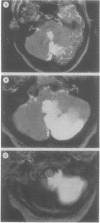Abstract
We report 10 cases of cerebellar infarction in the territory of the medial branch of the posterior inferior cerebellar artery (mPICA). Axial sections on MRI through the middle of the medulla and the cerebellum showed the infarction as a triangular area with a dorsal base and a ventral apex directed towards the fourth ventricle. The infarct also involved the lateral and dorsal medulla when the mPICA supplied all or part of these regions. Three clinical patterns were observed: 1) pseudolabyrinthine signs with or without dysmetria and ataxia when the medulla was spared; marked axial lateropulsion was present in most cases; 2) complete or incomplete Wallenberg's syndrome, when the medulla was involved; 3) silent infarction. These syndromes are precisely those previously attributed to PICA occlusion without distinction of the branch involved. No alteration of consciousness was recorded and spontaneous recovery was the rule. Cerebellar infarction in the distribution of the mPICA can be regarded as a benign condition with a good prognosis.
Full text
PDF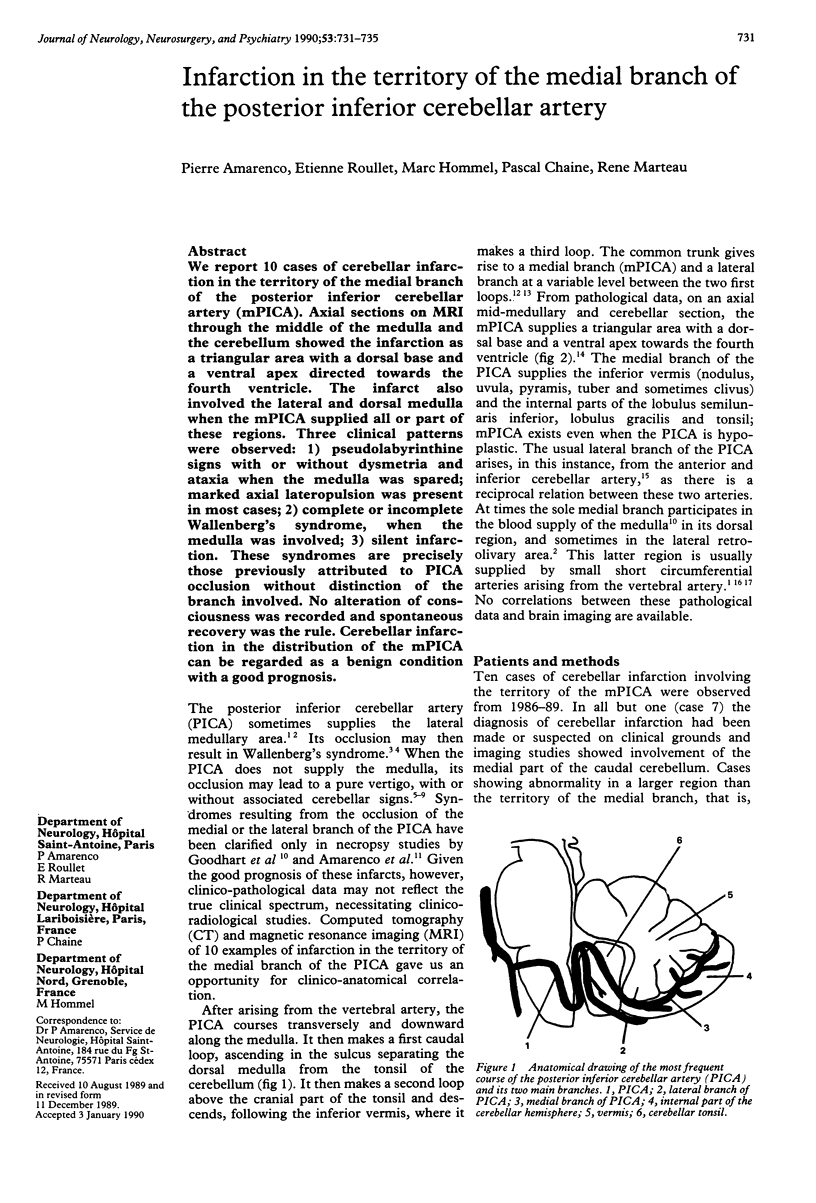
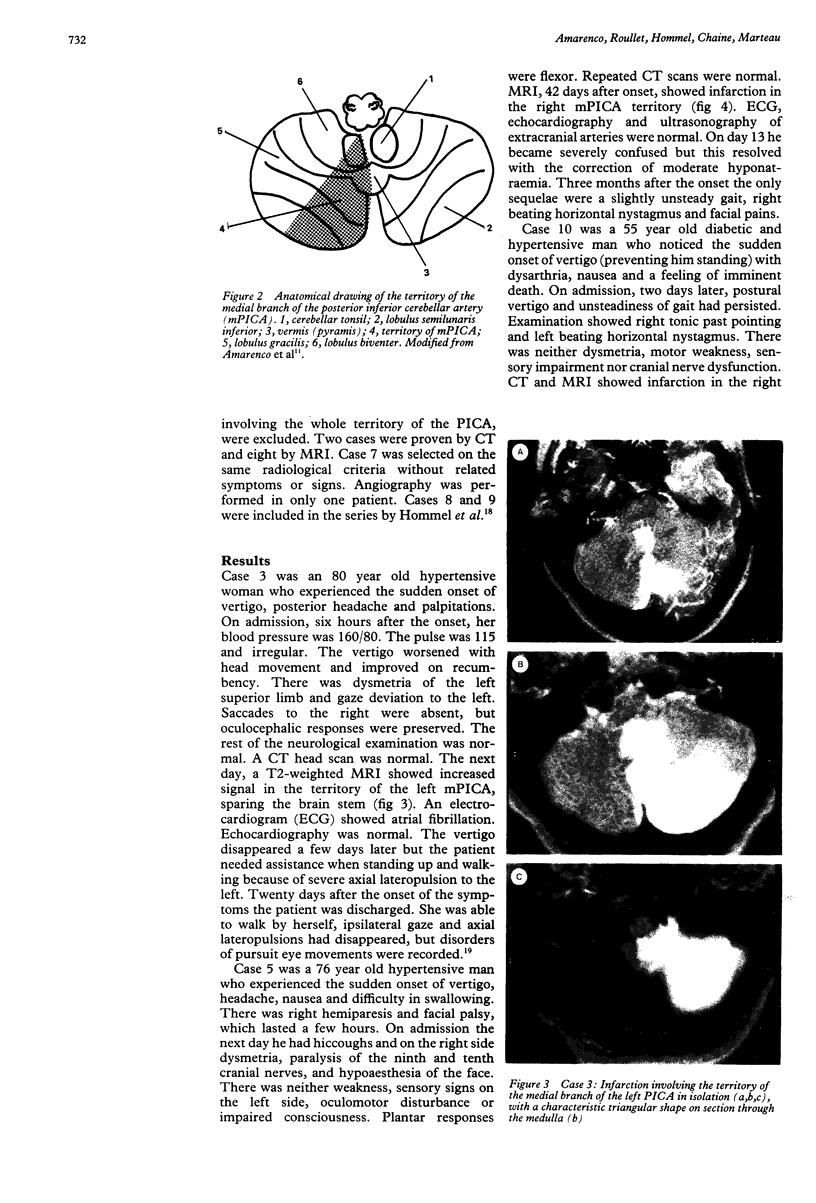
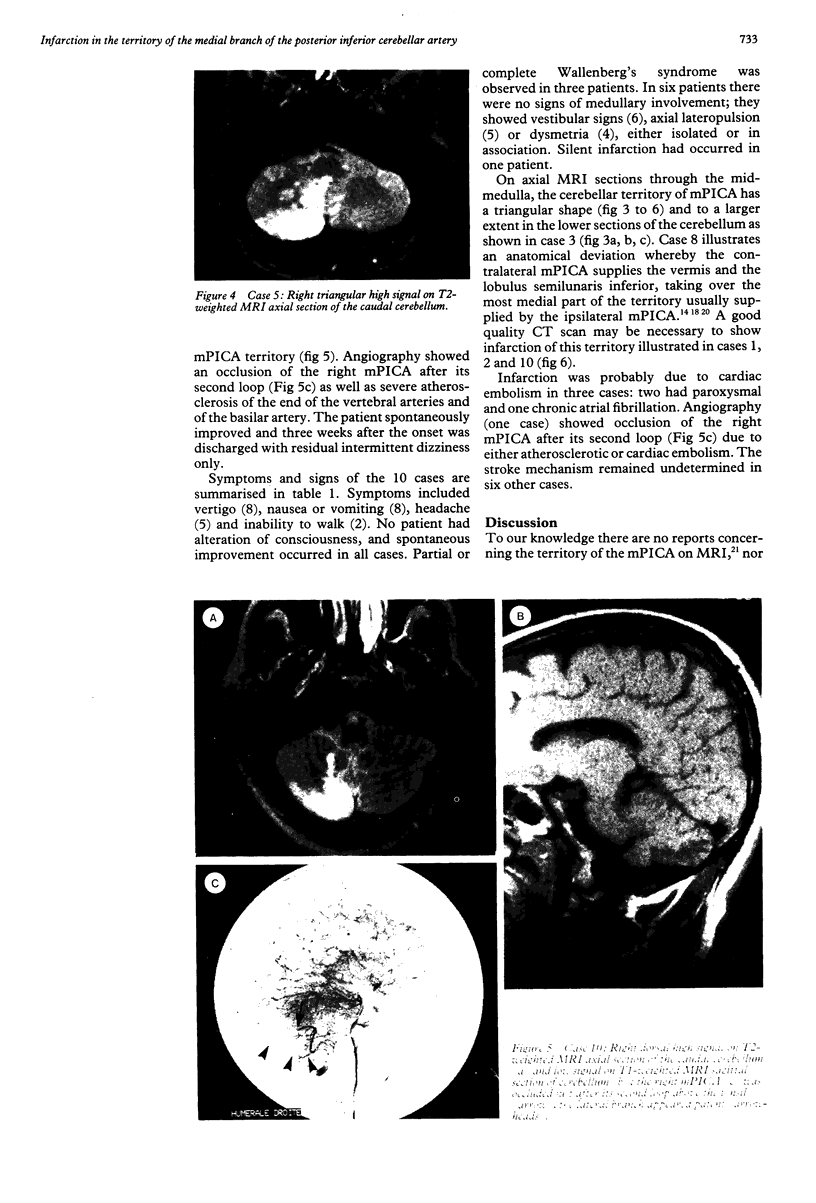
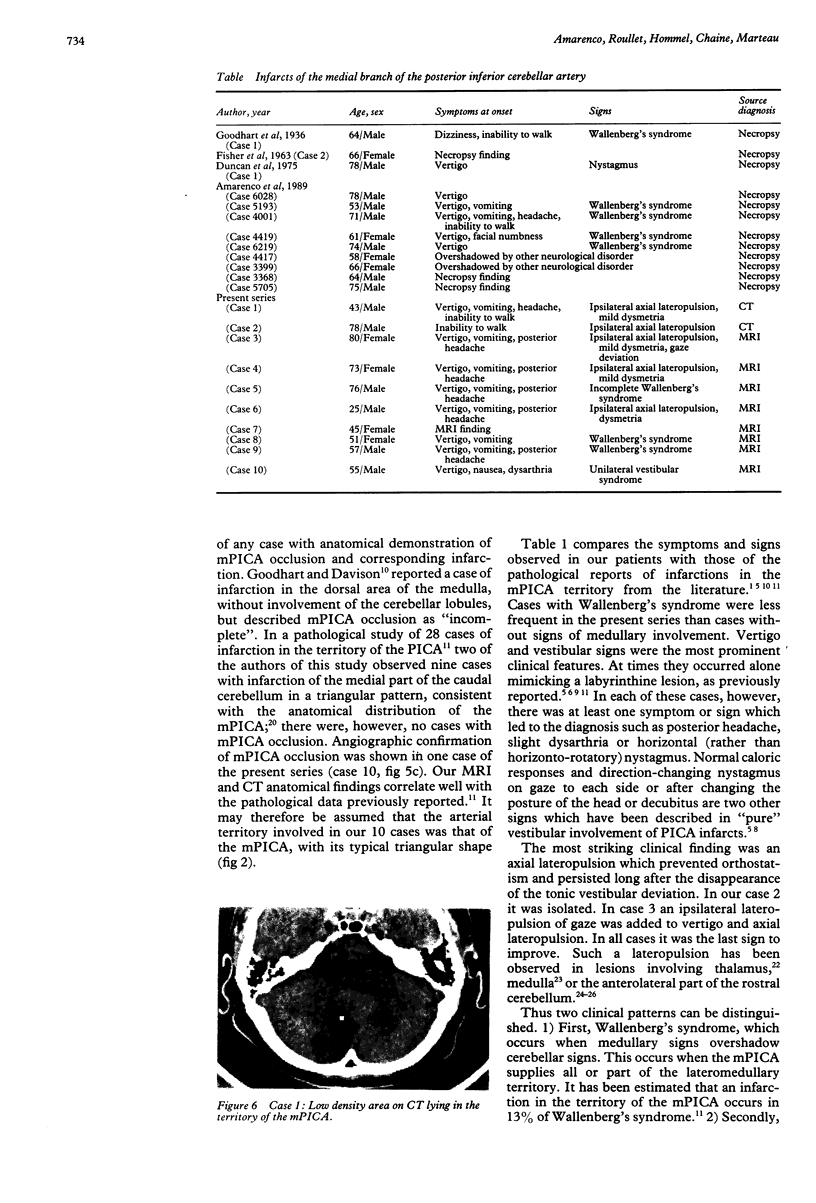
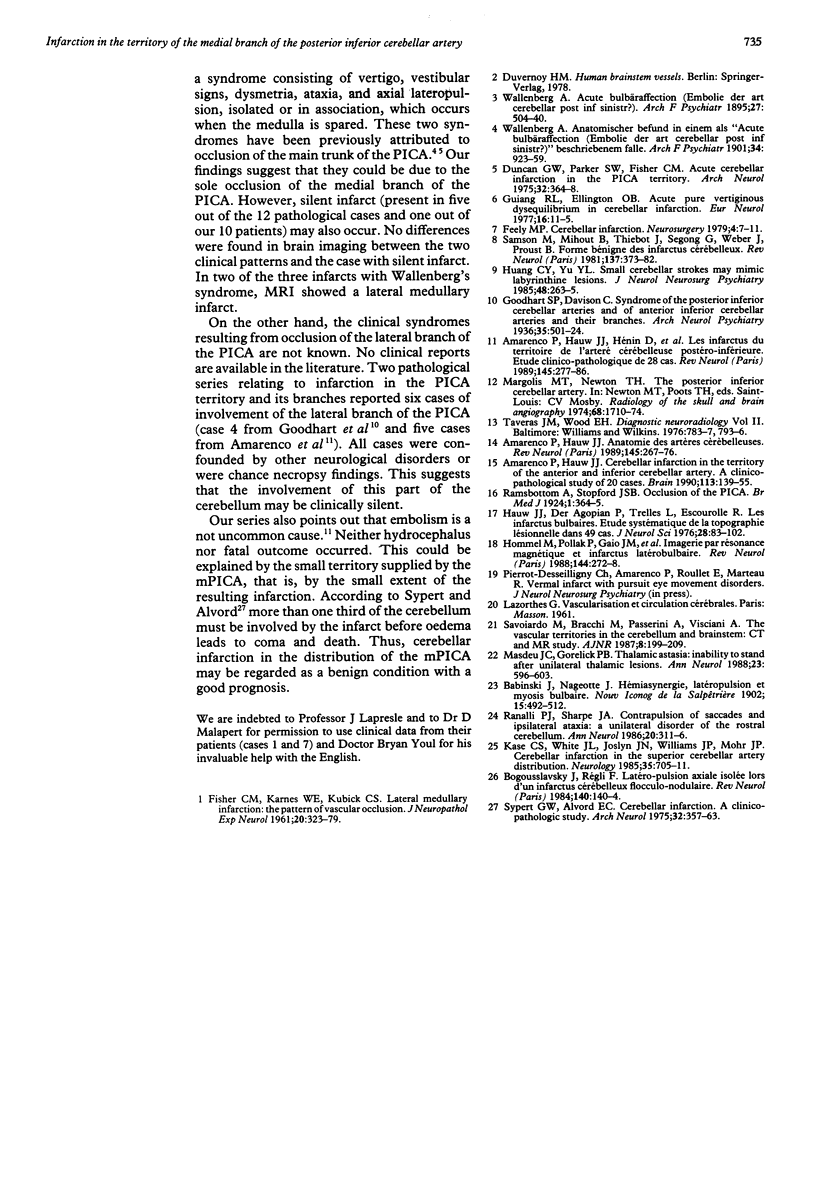
Images in this article
Selected References
These references are in PubMed. This may not be the complete list of references from this article.
- Amarenco P., Hauw J. J. Anatomie des arteres cerebelleuses. Rev Neurol (Paris) 1989;145(4):267–276. [PubMed] [Google Scholar]
- Amarenco P., Hauw J. J. Cerebellar infarction in the territory of the anterior and inferior cerebellar artery. A clinicopathological study of 20 cases. Brain. 1990 Feb;113(Pt 1):139–155. doi: 10.1093/brain/113.1.139. [DOI] [PubMed] [Google Scholar]
- Amarenco P., Hauw J. J., Hénin D., Duyckaerts C., Roullet E., Laplane D., Gautier J. C., Lhermitte F., Buge A., Castaigne P. Les infarctus du territoire de l'artère cérébelleuse postéro-inférieure. Etude clinico-pathologique de 28 cas. Rev Neurol (Paris) 1989;145(4):277–286. [PubMed] [Google Scholar]
- Bogousslavsky J., Regli F. Latéro-pulsion axiale isolée lors d'un infarctus cérébelleux flocculo-nodulaire. Rev Neurol (Paris) 1984;140(2):140–143. [PubMed] [Google Scholar]
- Duncan G. W., Parker S. W., Fisher C. M. Acute cerebellar infarction in the PICA territory. Arch Neurol. 1975 Jun;32(6):364–368. doi: 10.1001/archneur.1975.00490480030002. [DOI] [PubMed] [Google Scholar]
- FISHER C. M., KARNES W. E., KUBIK C. S. Lateral medullary infarction-the pattern of vascular occlusion. J Neuropathol Exp Neurol. 1961 Jul;20:323–379. doi: 10.1097/00005072-196107000-00001. [DOI] [PubMed] [Google Scholar]
- Feely M. P. Cerebellar infarction. Neurosurgery. 1979 Jan;4(1):7–11. doi: 10.1227/00006123-197901000-00003. [DOI] [PubMed] [Google Scholar]
- Guiang R. L., Jr, Ellington O. B. Acute pure vertiginous dysequilibrium in cerebellar infarction. Eur Neurol. 1977;16(1-6):11–15. doi: 10.1159/000114874. [DOI] [PubMed] [Google Scholar]
- Hauw J. J., Der Agopian P., Trelles L., Escourolle R. Les infarctus bulbaires. Etude systématique de la topographie lésionnelle dans 49 cas. J Neurol Sci. 1976 May;28(1):83–102. doi: 10.1016/0022-510x(76)90050-2. [DOI] [PubMed] [Google Scholar]
- Hommel M., Pollak P., Gaio J. M., Besson G., Borgel F., Le Bas J. F., Perret J. Imagerie par résonance magnétique et infarctus latérobulbaire. Rev Neurol (Paris) 1988;144(4):272–278. [PubMed] [Google Scholar]
- Huang C. Y., Yu Y. L. Small cerebellar strokes may mimic labyrinthine lesions. J Neurol Neurosurg Psychiatry. 1985 Mar;48(3):263–265. doi: 10.1136/jnnp.48.3.263. [DOI] [PMC free article] [PubMed] [Google Scholar]
- Kase C. S., White J. L., Joslyn J. N., Williams J. P., Mohr J. P. Cerebellar infarction in the superior cerebellar artery distribution. Neurology. 1985 May;35(5):705–711. doi: 10.1212/wnl.35.5.705. [DOI] [PubMed] [Google Scholar]
- Masdeu J. C., Gorelick P. B. Thalamic astasia: inability to stand after unilateral thalamic lesions. Ann Neurol. 1988 Jun;23(6):596–603. doi: 10.1002/ana.410230612. [DOI] [PubMed] [Google Scholar]
- Ranalli P. J., Sharpe J. A. Contrapulsion of saccades and ipsilateral ataxia: a unilateral disorder of the rostral cerebellum. Ann Neurol. 1986 Sep;20(3):311–316. doi: 10.1002/ana.410200307. [DOI] [PubMed] [Google Scholar]
- Samson M., Mihout B., Thiebot J., Segond G., Weber J., Proust B. Forme bénigne des infarctus cérébelleux. Rev Neurol (Paris) 1981;137(5):373–382. [PubMed] [Google Scholar]
- Savoiardo M., Bracchi M., Passerini A., Visciani A. The vascular territories in the cerebellum and brainstem: CT and MR study. AJNR Am J Neuroradiol. 1987 Mar-Apr;8(2):199–209. [PMC free article] [PubMed] [Google Scholar]
- Sypert G. W., ALvord E. C., Jr Cerebellar infarction. A clinicopathological study. Arch Neurol. 1975 Jun;32(6):357–363. doi: 10.1001/archneur.1975.00490480023001. [DOI] [PubMed] [Google Scholar]



